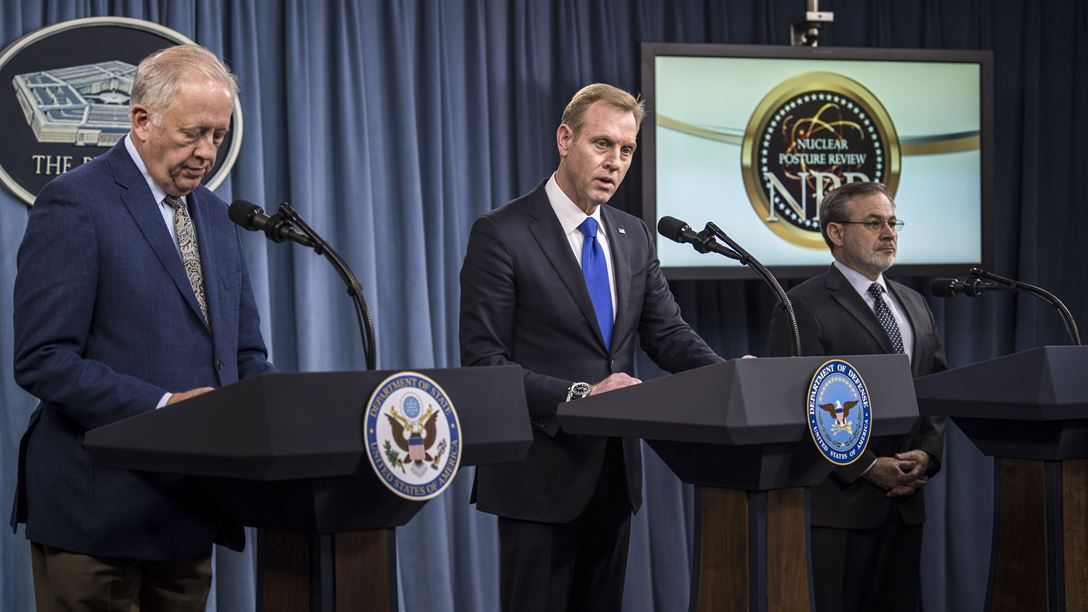 DoD photo by Navy Petty Officer 1st Class Kathryn E. Holm
DoD photo by Navy Petty Officer 1st Class Kathryn E. Holm
Low-Yield Warheads in the Nuclear Posture Review
The Trump administration has stated its commitment to modernizing the U.S. nuclear arsenal by including the creation of a low-yield nuclear warhead. This would be the first new nuclear warhead to be developed by the United States arsenal since the W-88 began development in 1984. While the Department of Defense reasons that updating the United States’ nuclear capabilities is needed to retain the ability to respond to nuclear threats abroad, critics argue that creating new, “more efficient” nuclear weapons lowers the threshold for potential nuclear war.
Last week, the Department of Defense released the 2018 Nuclear Posture Review (NPR). The review was commissioned shortly after President Trump assumed office and while it reconfirms the United States’ commitment to honoring its formal promises to allies, it also outlines the plan to update the nuclear arsenal through modernization and engineering new warheads to give the military flexible and low-yield options.
The United States relies on the strategic nuclear Triad for its nuclear capabilities: submarines with submarine-launched ballistic missiles (SLBMs), land-based intercontinental ballistic missiles (ICBMs), and strategic bombers that carry air-launched cruise missiles (ALCMs) and gravity bombs. While the Triad provides a diversity of options—and leaves little room for an adversary to survive a retaliatory second strike by the U.S.—the NPR suggests modernizing not only the Triad’s delivery systems, but the warhead programs as well.
The Nuclear Posture Review states that “[while] the United States has continued to reduce the number and salience of nuclear weapons, others, including Russia and China, have moved in the opposite direction.” In the eyes of the DoD, America’s current nuclear weapons infrastructure suffers from being dated and underfunded. Versatility and flexibility are required of our nuclear arsenal to maintain effectiveness—elements that the DoD does not believe the current arsenal exhibits.
For nuclear weapons to be a credible deterrent threat to adversaries, those adversaries must believe that the United States is willing and able to use them. Proponents of low-yield warheads contend that less destructive nuclear weapons make a proportional response more possible. If it is widely known that the U.S. views its nuclear capabilities as too destructive to use, other states will not believe in the credibility of their deterrence. The Review states that expanding “flexible U.S. nuclear options now, to include low-yield options, is important for the preservation of credible deterrence against regional aggression” and goes on to say “[to] be clear, this is not intended to enable, nor does it enable, ‘nuclear war-fighting’.”
However, critics say that it can do exactly this. Senior official for arms control on the National Security Council under the Obama administration, Jon Wolfsthal, told Newsweek, “[modernization] lowers the nuclear threshold in the U.S. by giving the Pentagon ‘more options to use nuclear weapons that wouldn’t be as devastating, which in some ways makes them more tempting’ to use.”
More effective low-yield nuclear weapons open the door for the Pentagon to use in case of an “emergency.” In the Posture Review, the Department of Defense argues that creating a large arsenal of low-yield warheads shows the credibility of the United States’ ability to deter nuclear threat, but some argue that the more nuclear weapons there are in an arsenal, the more likely a country is to use them. Lowering the yield of a nuclear warhead to be less destructive creates a lower threshold of what could be considered a credible reason to use them. An example of this could be hardened targets or underground facilities.
Critics could also argue that other states will see what the United States is developing with its nuclear arsenal and decide to create a more effective nuclear arsenal for themselves. This helps create a world in which the likelihood of a nuclear event happening during a conflict is greater, escalating any war or situation in which this takes place. New nuclear weapons have the potential to create an arms race with nations not bound to the Non-Proliferation Treaty.
Within the NPR, the Department of Defense highlights that deterrence is not the sole purpose of a nuclear weapon. This illustrates that the DoD is willing to utilize these low-yield nuclear weapons should it be deemed appropriate to ensure the “achievement of U.S. objectives if deterrence fails” and the “capacity to hedge against an uncertain future.” Creating low-yield nuclear warheads does not necessarily mean that nuclear war is going to break out at any moment as critics fear, but they do offer a lower barrier to use in a situation the president deems to be an emergency.





